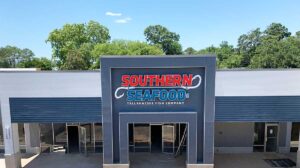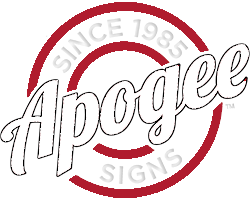Elevate Your Building’s Presence with Architectural Signage (Building Signs) by Apogee Signs

At Apogee Signs, we understand the power of a strong first impression. Architectural signage, also known as building signs, is a key element in establishing your brand identity and attracting customers. These custom-designed signs are strategically placed on your building’s facade to maximize visibility and functionality.
Beyond Visibility: The Benefits of Architectural Signage
- Enhanced Brand Recognition: Building signs is more than just displaying your business name. By incorporating unique design elements, materials, and colors, you create a memorable brand statement that sets you apart.
- Improved Wayfinding: Guide visitors and tenants effortlessly throughout your building with clear and concise directional signage.
- Accessibility Compliance: Ensure your building is inclusive for everyone with ADA-compliant signs.
- Increased Safety: Provide clear safety instructions and information for emergencies.
Why Choose Apogee Signs for Your Architectural Signage Needs?
- Custom Design & Fabrication: Our experienced team collaborates with you to design architectural signs that meets your specific needs, budget, and brand aesthetic.
- High-Quality Materials: We use only the finest materials to ensure your signs are durable, weather-resistant, and long-lasting.
- Code-Compliant Installations: Our certified installers guarantee that your signage meets all local and state building codes.
- Unmatched Customer Service: We prioritize clear communication throughout the entire process, keeping you informed and involved every step of the way.
Ready to Take the Next Step?
Investing in high-quality architectural signage is an investment in your business’s success. Contact Apogee Signs today for a free consultation and learn how we can transform your building’s facade into a powerful branding tool.
Elevate Your Building with Architectural Signage

At Apogee Signs, we understand the power of a strong first impression. Architectural signage, also known as building signs, is a key element in establishing your brand identity and attracting customers. These custom-designed signs are strategically placed on your building’s facade to maximize visibility and functionality.
Ready to Take the Next Step?
Investing in high-quality architectural signage is an investment in your business’s success. Contact Apogee Signs today for a free consultation and learn how we can transform your building’s facade into a powerful branding tool.
Request A Quote
Common Questions About Architectural Signage
This question seeks a basic definition of architectural signage, which can be described as signage elements integrated into the design and structure of a building or space to provide information, wayfinding, branding, or decorative elements.
This question delves into the design process, including factors like visibility, legibility, aesthetics, materials, and compliance with local regulations. It can also include discussions about how the signage complements the architecture of the space.
Selecting suitable materials for architectural signage is essetial for durability, aesthetics, and functionality. Answers to this question might include considerations about weather resistance, indoor vs. outdoor use, sustainability, and cost-effectiveness.
This question addresses the legal and regulatory aspects of signage installation. Answers may include information about zoning codes, permits, ADA (Americans with Disabilities Act) compliance, and any local or national regulations that govern signage.
This question explores the role of signage in branding and navigation within a space. Answers might touch on how signage reinforces a company’s identity, how it aids visitors in finding their way, and how it can be designed to create a cohesive visual experience.
